Recent Mold Remediation Posts
Prevent Winter Mold Growth | SERVPRO of East Lansing/Haslett
1/8/2025 (Permalink)
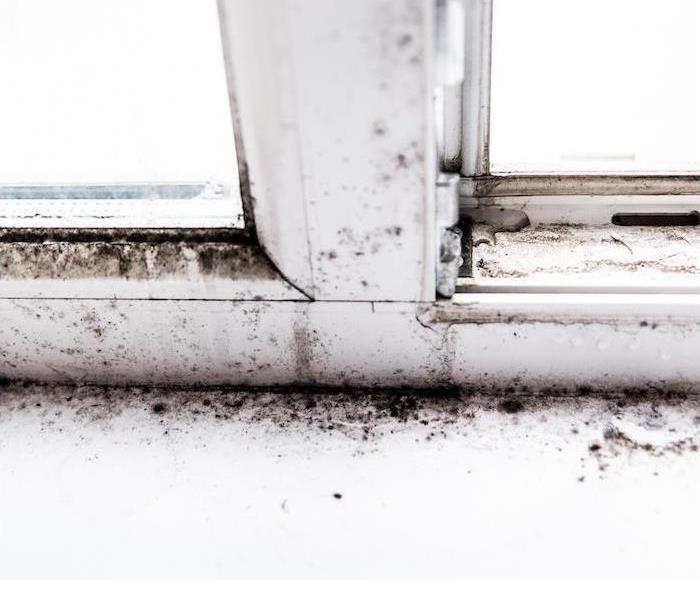 Prevent Winter Mold: Stop mold in its tracks with SERVPRO of East Lansing-Haslett's winter prevention tips!
Prevent Winter Mold: Stop mold in its tracks with SERVPRO of East Lansing-Haslett's winter prevention tips!
Winter in East Lansing comes with cold temperatures and lots of moisture, creating an ideal environment for mold to grow indoors. As snow piles up and temperatures hover below freezing, it’s important to keep your home dry and mold-free.
Understanding Winter Mold Risks
During the winter months, East Lansing experiences average temperatures ranging from 17°F to 31°F. Snowfall is abundant, often leaving a heavy layer of moisture on your roof and around your foundation. As the snow melts, water can seep into your home, creating the perfect conditions for mold growth. Additionally, the need to keep windows and doors closed for warmth can trap humidity inside, further contributing to moisture buildup.
Simple Ways to Prevent Mold This Winter
Keep Your Home Dry
Moisture control is the first step to stopping mold in its tracks. Use a dehumidifier in rooms that tend to be damp, such as basements or bathrooms. Make sure your home’s humidity level stays below 50% to limit the opportunity for mold to form.
Ensure Proper Ventilation
When it’s cold outside, it’s tempting to keep everything sealed up, but ventilation is key. Use exhaust fans in the kitchen and bathroom to remove excess moisture, and open windows when weather permits to allow fresh air to circulate. Make sure your dryer vents outside and your attic has proper airflow to prevent condensation buildup.
Check for Leaks and Ice Dams
Ice dams are common during East Lansing winters. When snow melts and refreezes at the edge of your roof, it can cause water to back up under shingles and into your home. Keep gutters clear of debris to prevent ice dams and inspect your roof for signs of leaks. Any water intrusion, no matter how small, can lead to mold.
Routine Maintenance Tips for Mold Prevention
Regularly Inspect Problem Areas
Mold loves basements, attics, and crawl spaces. Check these areas regularly, especially after snowstorms. Look for any signs of water damage or musty odors, which may indicate mold is beginning to grow.
Maintain Your HVAC System
Your heating system is critical during the winter, but it also affects indoor air quality. Make sure to change filters regularly and schedule maintenance for your HVAC system. SERVPRO® of East Lansing Haslett can also inspect and clean your ductwork to help reduce mold spores and improve air circulation.
Protect Your Home from Mold with SERVPRO of East Lansing Haslett
When it comes to keeping mold at bay all winter long, prevention is key. If you do find mold or water damage, it’s essential to act fast and get professional help. SERVPRO® of East Lansing Haslett is here to help restore your home and prevent further issues. Let us keep your home safe and dry this winter!
How to Prevent Mold Growth
8/7/2018 (Permalink)
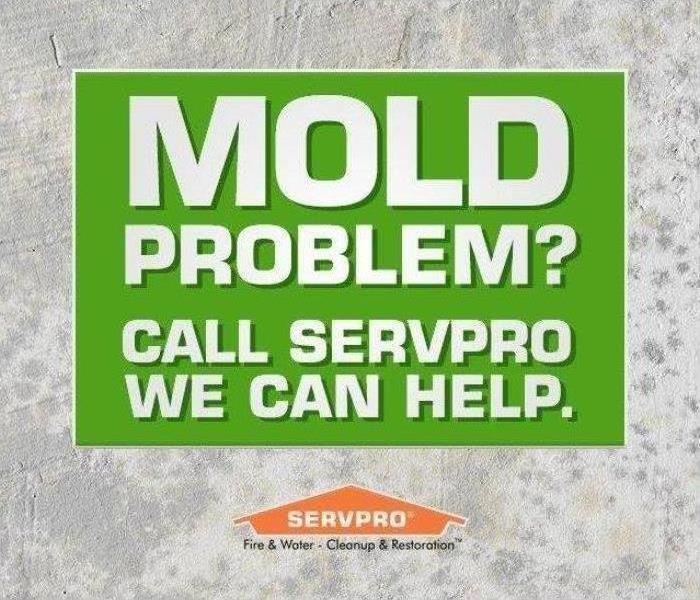 We're here to help!
We're here to help!
The key to preventing and stopping indoor mold growth is to control excessive moisture and condensation. Keeping susceptible areas in the home clean and dry is critical. In general, mold will not grow indoors without water, dampness or excessive moisture.
Three main factors contribute to condensation of water on building surfaces:- Relative Humidity: Condensation occurs when the air is saturated with water and it cannot hold any more moisture. For example, steam generated from bathroom showers or from cooking can fill up the air with moisture, which will then condense into drops of water on cooler surfaces, such as mirrors and windows. Where possible, localized sources of humidity, such as clothes dryers, should be directly vented to the outdoors. To lower indoor humidity during warm, humid weather, air conditioners and/or dehumidifiers should be used. In chronically damp areas such as basements or crawlspaces, it is often recommended that dehumidifiers be used to maintain humidity levels below 60 percent.
- Temperature: Warm air holds more moisture than cold air. Condensation occurs when warm humid air comes into contact with a cold surface and the moisture condenses into water. This can often be seen on single-pane windows, where water condenses and then runs down, causing the wood frames and sills to rot and the wall under the windows to blister. Condensation can occur on exterior walls, particularly north-facing walls, if they are not properly insulated. Other chronically cold surfaces, such as cold water pipes, should be covered with insulation to help prevent condensation.
- Poor Ventilation: Indoor humidity can build up if there is not enough ventilation and exchange of indoor and outdoor air. Where there is little or no air movement, such as behind dressers and cabinets, surfaces can remain cooler than surrounding areas, which can lead to increased condensation and mold growth. It is recommended that the area be ventilated and the occupants use exhaust fans (vented to the outdoors) to remove moisture from high-humidity areas, particularly in bathrooms, kitchens and laundry areas. Furniture should be moved slightly away from walls so that air can freely pass behind it. Air should be allowed to circulate between rooms and regularly ventilate to remove humid air. Fans should be used as needed.
Other things that can be done are to clean and repair gutters regularly, make sure the ground slopes down and away from the home’s foundation and keep air conditioner drip pans and drain lines clean. In addition, in air conditioned buildings in hot and humid climates, vinyl wall coverings on the interior sides of exterior walls should not be used, as these materials can trap moisture, resulting in mold growth underneath them.
In the case of floods or leaking pipes, any standing water should be promptly removed and water-damaged materials should either be dried out and cleaned, or removed and replaced. Porous materials that are wet for more than 48 hours are likely to produce mold growth and should be discarded.
If you're concerned about moisture, mold, or water damage in your home or business, call SERVPRO of East Lansing/Haslett at 517-999-0789. We're here to help!
If You Suspect Mold, Call Us Today!
7/26/2018 (Permalink)
 Excessive mold and water damage on the frame of this basement slider.
Excessive mold and water damage on the frame of this basement slider.
Microscopic mold spores naturally occur almost everywhere, both outdoors and indoors. This makes it impossible to remove all mold from a home or business. Therefore, mold remediation reduces the mold spore count back to its natural or baseline level. Some restoration businesses advertise “mold removal” and even guarantee to remove all mold, which is a fallacy. Consider the following mold facts:
- Mold is present almost everywhere, indoors and outdoors.
- Mold spores are microscopic and float along in the air and may enter your home through windows, doors, or AC/heating systems or even hitch a ride indoors on your clothing or a pet.
- Mold spores thrive on moisture. Mold spores can quickly grow into colonies when exposed to water. These colonies may produce allergens and irritants.
- Before mold remediation can begin, any sources of water or moisture must be addressed. Otherwise, the mold may return.
- Mold often produces a strong, musty odor and can lead you to possible mold problem areas.
- Even higher-than-normal indoor humidity can support mold growth. Keep indoor humidity below 45 percent.
If your home or business has a mold problem, we can inspect and assess your property and use our specialized training, equipment, and expertise to remediate your mold infestation.
If You Suspect Mold, Call Us Today – 517-999-0789
Conditions In Haslett Might Be Right For Mold
7/19/2018 (Permalink)
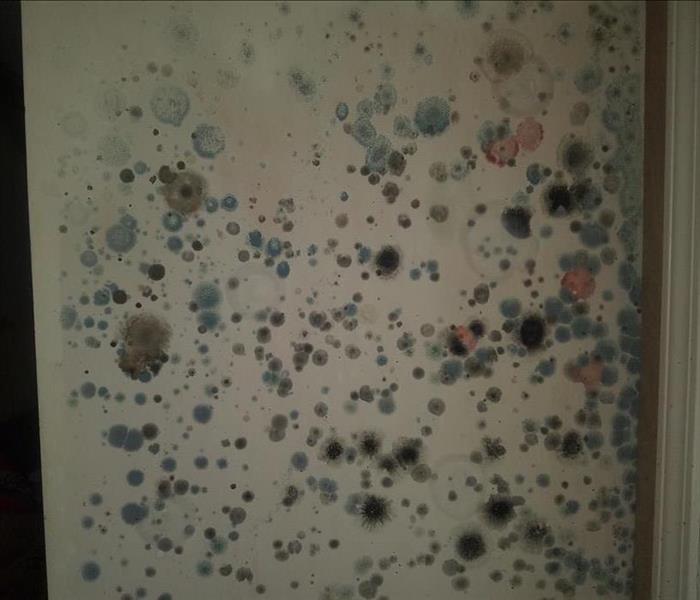 Mold on a wall in a Haslett home.
Mold on a wall in a Haslett home.
It’s estimated that more than 1 million types of mold exist, yet less than 10 percent have actually been named. This means mold is very common in both indoor and outdoor environments. While mold and humans can sometimes co-exist without issue, there are certain species of mold that can cause health effects for some people.
If the right conditions exist, mold will grow. Those conditions include:
- Water - Different mold types require varying amounts of liquid before growth begins.
- Temperature - Normal indoor temperatures will promote mold growth.
- Time - Initial mold colonizers can take hold within one day after being exposed to an adequate water supply.
Mold growth can occur in any home, so it’s important to keep an eye out for situations that might promote mold activity. Roof/chimney leaks, wet basements, or condensation from ducts that dampen surrounding insulation are just a few examples of issues that make a house a prime target for mold growth.
If you suspect mold in your home, call SERVPRO of East Lansing/Haslett to assess the situation. We have the knowledge, tools and track record to effectively remedy mold in your home or business.
What to Do:
- Stay out of affected areas.
- Turn off the HVAC system and fans.
- Contact SERVPRO of East Lansing/Haslett for mold remediation services.
What Not to Do:
- Don’t touch or disturb the mold.
- Don’t blow air across any surfaces with visible or suspected mold growth.
- Don’t attempt to dry the area yourself.
- Don’t spray bleach or other disinfectants on the mold.
About Our Mold Remediation Services
SERVPRO of East Lansing/Haslett specializes in mold cleanup and restoration, in fact, it’s a cornerstone of our business. Our crews are highly trained restoration professionals that use specialized equipment and techniques to properly remedy your mold problem quickly and safely.
If You See Signs of Mold, Call Us Today – 517-999-0789
Does your East Lansing Home have a Mold Problem?
6/13/2018 (Permalink)
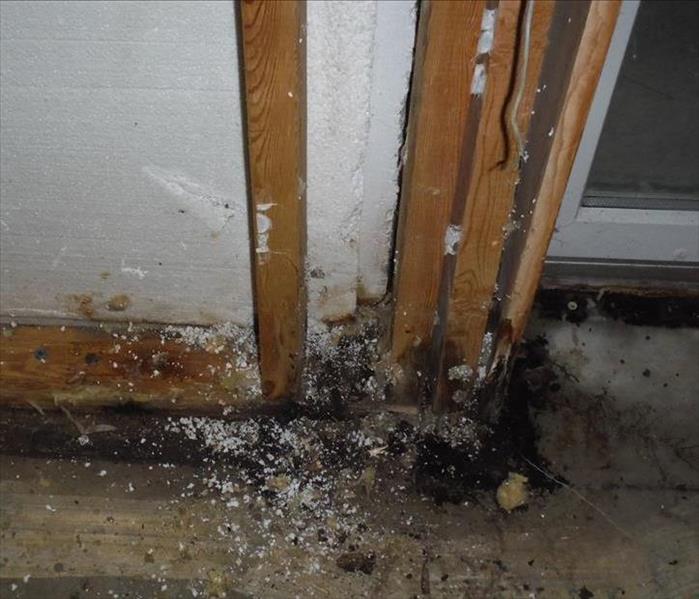 Mold was hiding behind drywall and insulation in this Haslett home.
Mold was hiding behind drywall and insulation in this Haslett home.
Microscopic mold spores naturally occur almost everywhere, both outdoors and indoors. This makes it impossible to remove all mold from a home or business. Therefore, mold remediation reduces the mold spore count back to its natural or baseline level. Some restoration businesses advertise “mold removal” and even guarantee to remove all mold, which is a fallacy. Consider the following mold facts:
- Mold is present almost everywhere, indoors and outdoors.
- Mold spores are microscopic and float along in the air and may enter your home through windows, doors, or AC/heating systems or even hitch a ride indoors on your clothing or a pet.
- Mold spores thrive on moisture. Mold spores can quickly grow into colonies when exposed to water. These colonies may produce allergens and irritants.
- Before mold remediation can begin, any sources of water or moisture must be addressed. Otherwise, the mold may return.
- Mold often produces a strong, musty odor and can lead you to possible mold problem areas.
- Even higher-than-normal indoor humidity can support mold growth. Keep indoor humidity below 45 percent.
If your home or business has a mold problem, we can inspect and assess your property and use our specialized training, equipment, and expertise to remediate your mold infestation.
If You See Signs of Mold, Call Us Today – 517-999-0789
Serious Mold in Unoccupied Home
4/10/2018 (Permalink)
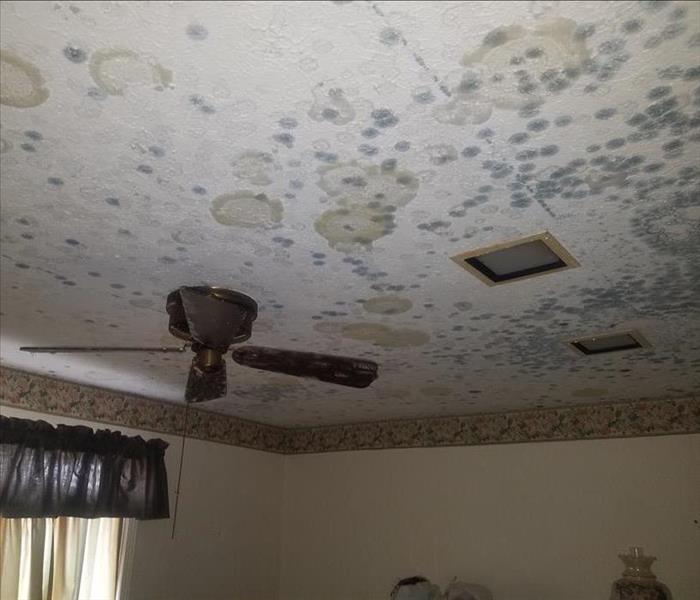 Mold on the ceiling and fan on the second floor.
Mold on the ceiling and fan on the second floor.
A lot of things can go wrong when a home is left unoccupied for an extended period of time, especially if there is no caretaker to check in periodically. Such was the unforunate case for this East Lansing home.
This home had been left unattended for about a year. A family member of the homeowner received a large utility bill and had a handy-man go check out what was going on. The water pump went out and the house had not been winterized, and with the cold temperatures of Michigan's winter season, pipes were freezing and bursting. Water was trapped between the first floor ceiling and second floor, causing the entire first floor ceiling to collapse in the living room. Due to the warm temperature of the home and undisturbed air, mold and bacteria began to form everywhere. Pink, blue, green, and black spots covered the walls and ceilings, mold had begun to eat away at wood furniture and knickknacks, and a thick, white mold covered the underside of the ceiling that had collapsed.
Taking proper precautions when a home will be unoccupied is imperative. Hiring a handy-man or family friend to check on the property regularly, maintaining insurance, and keeping an eye on utility bills can prevent a massive mold infestation from forming, saving you thousands of dollars.
About Our Mold Remediation Services
SERVPRO of East Lansing/Haslett specializes in mold cleanup and restoration, in fact, it’s a cornerstone of our business. Our crews are highly trained restoration professionals that use specialized equipment and techniques to properly remediate your mold problem quickly and safely.
If You See Signs of Mold, Call Us Today – 517-999-0789
Mold Remediation at Jackson, MI Golf Course
12/4/2017 (Permalink)
 Just one of the areas affected in this 4,000 square foot clubhouse.
Just one of the areas affected in this 4,000 square foot clubhouse.
This Jackson, MI golf course has been in business since 1960. Each year, the owners will close during the winter season, and head down to Florida, sending someone in check on the clubhouse every other week. During this particular February, a pipe burst in the clubhouse between checks. Everything in the clubhouse remained functioning as normal, such as the heat, which combined with the moisture from the pipe burst created the perfect breeding grounds for microbial growth.
SERVPRO of East Lansing/Haslett was able to get our crews down to Jackson as soon as the owners found out about the loss. A thorough inspection revealed mold covering 70% of surfaces in the clubhouse. Chairs were rusted, contaminated water covered the floors, tables, walls, and ceilings were covered in mold. This turned out to be a complete tear out and rebuild - especially since this is a business where food and drinks are served.
Our crews worked tirelessly setting up equipment, doing demolitions, and getting the reconstruction squared away.
Restoring Commercial Properties Presents Unique Challenges
Our professionals are trained to be mindful of legal and environmental concerns and strive to fully restore the damaged area while working within your budgetary constraints. We understand that every hour spent cleaning up is an hour of lost revenue and productivity. So when an emergency situation arises in your business, give us a call and we’ll be there fast with the help you need.
About SERVPRO of East Lansing/Haslett
SERVPRO of East Lansing/Haslett specializes in the cleanup and restoration of commercial and residential property after a water damage event. Our staff is highly trained in property damage restoration. From initial and ongoing training at SERVPRO’s corporate training facility to regular IICRC-industry certification, rest assured our staff is equipped with the knowledge to restore your property.
The Mold Remediation Process
Every mold infestation is different, from the extent and type of growth, to the variety of materials affected. Each scenario requires a unique solution, but the general process stays the same. When you discover mold, call us at 517-999-0789 and we will go through our standard mold remediation process:
- Inspection and Mold Damage Assessment
- Mold Containment
- Air Filtration
- Removing Mold and Mold-Infested Materials
- Cleaning Contents and Belongings
- Restoration
If You See Signs of Mold, Call Us Today – 517-999-0789
Helpful Tips on Mold Prevention
12/1/2017 (Permalink)
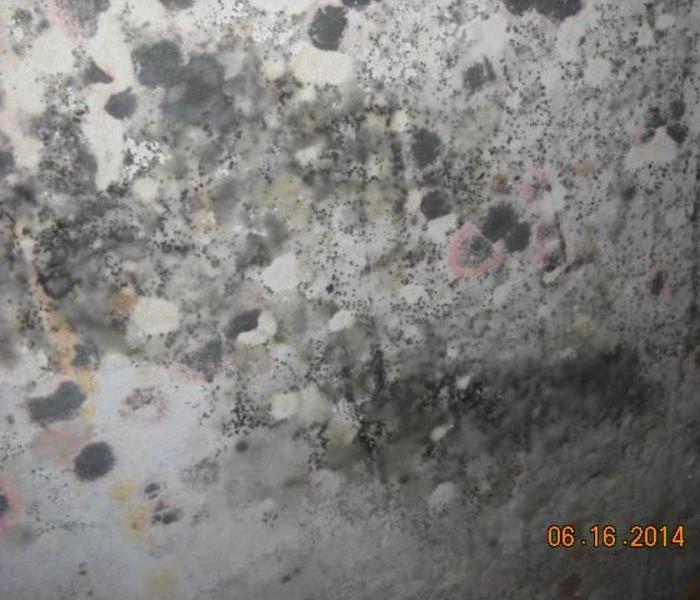 Serious mold growth in a Mason, MI home.
Serious mold growth in a Mason, MI home.
Michigan's humid climate creates the ideal breeding ground for microbial growth in your home. Here are some tips from Mother Nature Network to help prevent harmful microbial growth in your home.
1. Identify problem areas in your home and correct them. You can't mold-proof your home, but you can make it mold-resistant. Do an audit of your home: where are the problem areas? Does the basement flood? Do you notice frequent condensation on an upstairs window? Is there a water stain on the ceiling from a persistent leak? Preventing mold from growing or spreading might be as simple as ripping up carpet in a damp basement, installing mold-resistant products, or repairing damaged gutters. Or it may be a matter of major excavation and waterproofing. Whatever the case, address the problem now. It might cost some money up front, but it will surely be more costly down the road if mold continues to grow unchecked.
2. Dry wet areas immediately. Mold can't grow without moisture, so tackle wet areas right away. Seepage into the basement after a heavy rainfall, accumulation from a leaky pipe, even a spill on the carpet should be dried within 24 to 48 hours. If you've experienced a flood, remove water-damaged carpets, bedding, and furniture if they can't be completely dried. Even everyday occurrences need attention: don't leave wet items lying around the house, and make sure to dry the floor and walls after a shower. Don't leave wet clothes in the washing machine, where mold can spread quickly. Hang them to dry — preferably outside or in areas with good air circulation.
3. Prevent moisture with proper ventilation. It may be that your routine domestic activities are encouraging the growth of mold in your home. Make sure an activity as simple as cooking dinner, taking a shower, or doing a load of laundry doesn't invite mold by providing proper ventilation in your bathroom, kitchen, laundry room, and any other high-moisture area. Vent appliances that produce moisture — clothes dryers, stoves — to the outside (not the attic). Use AC units and dehumidifiers (especially in humid climates), but make sure they don’t produce moisture themselves by checking them periodically and cleaning them as directed by the manufacturer. Your energy-efficient home may be holding moisture inside, so open a window when cooking or washing dishes or showering, or run an exhaust fan.
4. Equip your home with mold-resistant products. Building a new home or renovating an old one? Use mold-resistant products like mold-resistant drywall or mold-resistant Sheetrock, and mold inhibitors for paints. Traditional drywall is composed of a gypsum plaster core pressed between plies of paper. Mold-resistant drywall is paperless — the gypsum core is covered in fiberglass, making the surface highly water-resistant. Moisture-resistant drywall is especially valuable in areas prone to wetness, such as bathrooms, laundry rooms, basements, and kitchens. Not only is traditional drywall more susceptible to mold than the paperless kind, but it is also difficult to rid of mold, and removal and replacement can be expensive. Mold-resistant gypsum board is also available; the core of the drywall is developed in such a way to prevent moisture absorption, and thus prevent mold growth.
5. Monitor humidity indoors. The EPA recommends keeping indoor humidity between 30 and 60 percent. You can measure humidity with a moisture meter purchased from your local hardware store. You'll also be able to detect high humidity by simply paying attention to potential problem areas in your home. Telltale signs of excessive humidity include condensation on windows, pipes, and walls. If you notice condensation, dry the surface immediately and address the source of moisture (for example, turn off a humidifier if water appears on the inside of nearby windows).
6. Direct water away from your home. If the ground around your home isn't sufficiently sloped away from the foundation, water may collect there and seep into your crawlspace or basement.
7. Clean or repair roof gutters. A mold problem might be a simple matter of a roof that is leaking because of full or damaged gutters. Have your roof gutters cleaned regularly and inspected for damage. Repair them as necessary, and keep an eye out for water stains after storms that may indicate a leak.
8. Improve air flow in your home. According to the EPA, as temperatures drop, the air is able to hold less moisture. Without good air flow in your home, that excess moisture may appear on your walls, windows and floors. To increase circulation, open doors between rooms, move furniture away from walls, and open doors to closets that may be colder than the rooms they’re in. Let fresh air in to reduce moisture and keep mold at bay.
9. Keep mold off household plants. They're beautiful and help keep your indoor air clean — and mold loves them. The moist soil in indoor plants is a perfect breeding ground for mold, which may then spread to other areas of your house. Instead of getting rid of your plants, try adding a bit of Taheebo tea to the water you give to your houseplants. The oil of this tree, which withstands fungi even in rain forests, helps hinder mold growth in plant soil and can be found at natural food stores.
Finally, educate yourself on your region's climate — be it the cold and wet Northeast, the hot and wet South, the hot and dry Southwest, or the cold and dry West — and how it responds to moisture. There is no one-size-fits-all solution when it comes to mold prevention. Knowing what works for your climate and your home is an important first step.
If your home or business has a mold problem, we can inspect and assess your property and use our specialized training, equipment, and expertise to remediate your mold infestation.
If You See Signs of Mold, Call Us Today – 517-999-0789
Follow These Safety Tips If You Suspect Mold
7/28/2017 (Permalink)
 Mold on a beam in a basement caused by a serious backup in an unoccupied home.
Mold on a beam in a basement caused by a serious backup in an unoccupied home.
If you see visible mold, do not disturb it. You can inadvertently spread the mold infestation throughout your home. When mold is disturbed, the mold can release microscopic mold spores which become airborne and can circulate inside your home.
What to Do:
- Stay out of affected areas.
- Turn off the HVAC system and fans.
- Contact SERVPRO of East Lansing / Haslett for mold remediation services.
What Not to Do:
- Don't touch or disturb the mold.
- Don't blow air across any surfaces with visible or suspected mold growth.
- Don't attempt to dry the area yourself.
- Don't spray bleach or other disinfectants on the mold.
About Our Mold Remediation Services
SERVPRO of East Lansing / Haslett specializes in mold cleanup and restoration, in fact, it's a cornerstone of our business. Our crews are highly trained restoration professionals that use specialized equipment and techniques to properly remediate your mold problem quickly and safely.
If You See Signs of Mold, Call Us Today - (517) 999-0789
What is Black Mold?
7/24/2017 (Permalink)
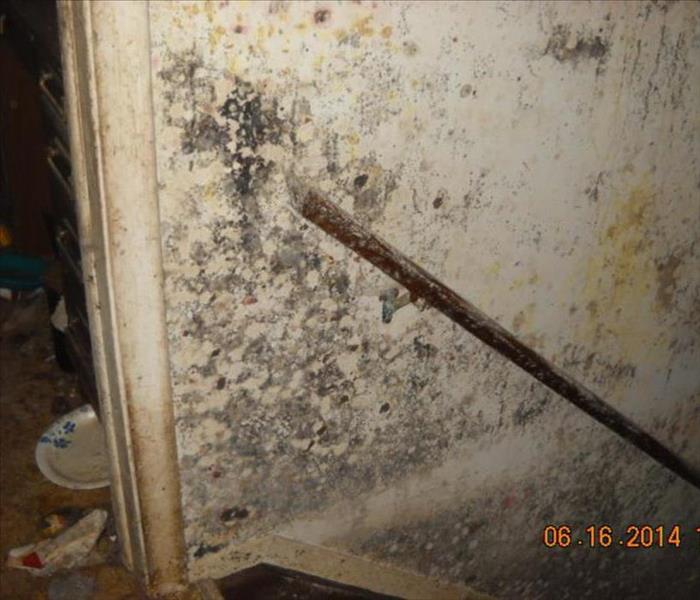 Black mold covered the walls of this Mason, MI home.
Black mold covered the walls of this Mason, MI home.
Stachybotrys chartarum is the type of mold often called “black mold” or “toxic mold”. Sensational news reports warn about the dangers of black mold and these stories can be alarming and confusing. Any mold in your home should be treated with caution – stay out of affected areas and don’t touch or disturb the mold.
Please refer to our Mold Damage Tips to learn more about mold and what to do until help arrives.
How Do I Tell If It’s Black Mold?
Since many types of mold can produce allergens and irritants, you should contact a qualified mold remediation company regardless of the color or type of mold. In many instances, multiple types of mold can exist in the same house or structure. If you suspect that you have a mold problem, contact SERVPRO of East Lansing/Haslett immediately.
If You See Signs of Mold, Call Us Today 517-999-0789.
Understanding Mold
When water intrudes into your property, mold growth can start in as little as 48 hours. Consider the following mold facts:
- Mold is present almost everywhere, indoors and outdoors.
- Mold spores are microscopic, float along in the air, and may enter your home through windows, doors, or AC/heating systems or even hitch a ride indoors on your clothing or a pet.
- Mold spores thrive on moisture. Mold spores can quickly grow into colonies when exposed to water. These colonies may produce toxins harmful to humans and pets.
- Before mold remediation can begin, any sources of water or moisture must be addressed. Otherwise the mold may return.
- Mold often produces a strong, musty odor, and that odor can lead you to possible mold problem areas.
- Even higher-than-normal indoor humidity can support mold growth. Keep indoor humidity below 45 percent.
Heightened Humidity Levels Can Escalate Mold Growth
6/15/2017 (Permalink)
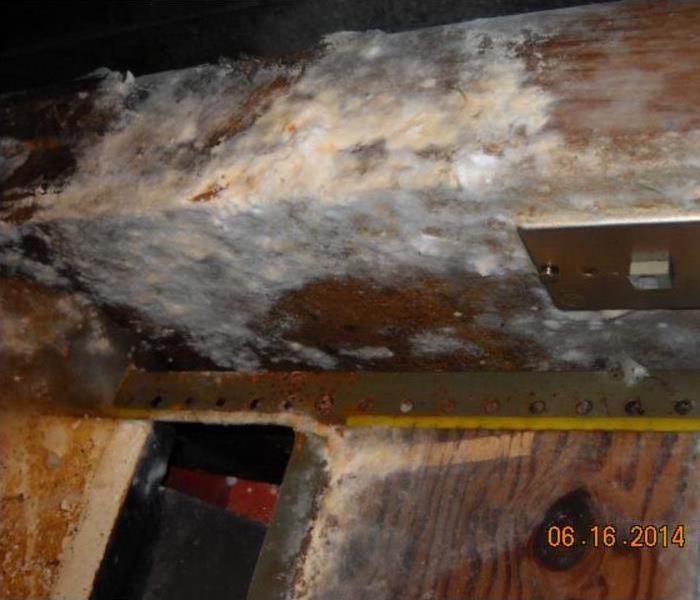 Serious mold growth on the wood beams of the basement in this unoccupied Mason, MI home.
Serious mold growth on the wood beams of the basement in this unoccupied Mason, MI home.
The hot, humid weather of Michigan's late spring and summer months bring about the perfect conditions for mold growth. While the ideal temperature for mold growth is between 77°F and 86°F, mold can grow at any temperature from 32°F up to 95°F.
Although mold is ubiquitous, it does require three things to grow - nutrients, moisture and time. Mold can obtain nutrients from many sources, but substances with a high cellulose content provide the most. A material which is highly cellulose is found in nearly every home - drywall. Other nutrient sources include dust and dander. Moisture aids in the decaying process caused by mold. When water vapor condenses on surfaces cooler than the air, mold is enabled to flourish. Mold growth begins 24 hours to 10 days after the provision of growing conditions.
Common causes in homes and businesses that escalate growing conditions are floods, leaky roofs, poor maintenance, and plumbing issues. Hidden leaks can go unnoticed for weeks, providing mold spores with the ideal conditions, and will usually be truly set in by the time it's discovered. Other areas in the home where condensation commonly forms are perimeter walls. Condensation forms when water vapor in the air meets cold surfaces and cools to become liquid. Perimeter walls are typically more susceptible to condensation gathering because of the cool outdoor air on the other side.
Basements are the most common area of the home to become affected by mold, as they are often the most damp because of the cool temperature. Unfinished basements are typically dark and go longer being undisturbed, giving spores ample time and conditions to grow.
SERVPRO of East Lansing/Haslett specializes in mold cleanup and restoration. Our crews are highly trained restoration professionals that use specialized equipment and techniques to properly remediate your mold problem quickly and safely.
If you suspect a mold issue in your home or business, call us today - 517.999.0789
Does your East Lansing home have a mold problem?
4/11/2017 (Permalink)
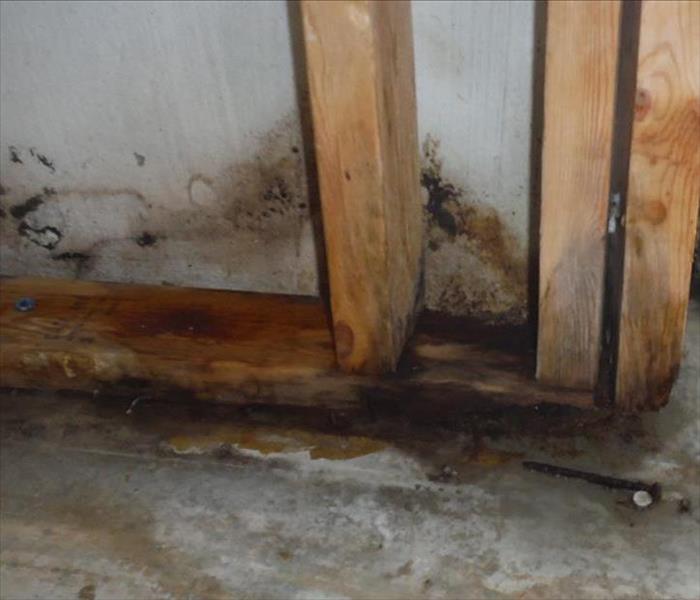 Mold was hiding behind drywall and insulation in this Haslett, MI home.
Mold was hiding behind drywall and insulation in this Haslett, MI home.
Microscopic mold spores naturally occur almost everywhere, both outdoors and indoors. This makes it impossible to remove all mold from a home or business. Therefore, mold remediation reduces the mold spore count back to its natural or baseline level. Some restoration businesses advertise “mold removal” and even guarantee to remove all mold, which is a fallacy. Consider the following mold facts:
- Mold is present almost everywhere, indoors and outdoors.
- Mold spores are microscopic and float along in the air and may enter your home through windows, doors, or AC/heating systems or even hitch a ride indoors on your clothing or a pet.
- Mold spores thrive on moisture. Mold spores can quickly grow into colonies when exposed to water. These colonies may produce allergens and irritants.
- Before mold remediation can begin, any sources of water or moisture must be addressed. Otherwise, the mold may return.
- Mold often produces a strong, musty odor and can lead you to possible mold problem areas.
- Even higher-than-normal indoor humidity can support mold growth. Keep indoor humidity below 45 percent.
If your home or business has a mold problem, we can inspect and assess your property and use our specialized training, equipment, and expertise to remediate your mold infestation.
If You See Signs of Mold, Call Us Today – 517-999-0789
 Prevent Winter Mold: Stop mold in its tracks with SERVPRO of East Lansing-Haslett's winter prevention tips!
Prevent Winter Mold: Stop mold in its tracks with SERVPRO of East Lansing-Haslett's winter prevention tips!





 24/7 Emergency Service
24/7 Emergency Service






